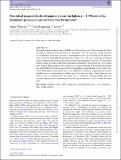Files in this item
Non-ideal magnetohydrodynamics versus turbulence – I. Which is the dominant process in protostellar disc formation?
Item metadata
| dc.contributor.author | Wurster, James Howard | |
| dc.contributor.author | Lewis, Benjamin T. | |
| dc.date.accessioned | 2020-06-25T16:30:08Z | |
| dc.date.available | 2020-06-25T16:30:08Z | |
| dc.date.issued | 2020-07 | |
| dc.identifier | 268403042 | |
| dc.identifier | 5fddaec1-8d3d-43c4-8347-4c3815f53019 | |
| dc.identifier | 000546679500025 | |
| dc.identifier | 85098247635 | |
| dc.identifier.citation | Wurster , J H & Lewis , B T 2020 , ' Non-ideal magnetohydrodynamics versus turbulence – I. Which is the dominant process in protostellar disc formation? ' , Monthly Notices of the Royal Astronomical Society , vol. 495 , no. 4 , pp. 3795-3806 . https://doi.org/10.1093/mnras/staa1339 | en |
| dc.identifier.issn | 0035-8711 | |
| dc.identifier.other | ORCID: /0000-0003-0688-5332/work/75610555 | |
| dc.identifier.uri | https://hdl.handle.net/10023/20155 | |
| dc.description | Funding: European Research Council under the European Community’s Seventh Framework Programme (FP7/2007-2013 grant agreement no. 339248); University of St Andrews (JW). National Aeronautics and Space Administration (NASA) through grant NN17AK90G and from the National Science Foundation (NSF) through grants no 1517488 and PHY-1748958 (BTL). | en |
| dc.description.abstract | Non-ideal magnetohydrodynamics (MHD) is the dominant process. We investigate the effect of magnetic fields (ideal and non-ideal) and turbulence (sub- and transsonic) on the formation of circumstellar discs that form nearly simultaneously with the formation of the protostar. This is done by modelling the gravitational collapse of a 1 M☉ gas cloud that is threaded with a magnetic field and imposed with both rotational and turbulent velocities. We investigate magnetic fields that are parallel/antiparallel and perpendicular to the rotation axis, two rotation rates, and four Mach numbers. Disc formation occurs preferentially in the models that include non-ideal MHD where the magnetic field is antiparallel or perpendicular to the rotation axis. This is independent of the initial rotation rate and level of turbulence, suggesting that subsonic turbulence plays a minimal role in influencing the formation of discs. Aside from first core outflows that are influenced by the initial level of turbulence, non-ideal MHD processes are more important than turbulent processes during the formation of discs around low-mass stars. | |
| dc.format.extent | 11293776 | |
| dc.language.iso | eng | |
| dc.relation.ispartof | Monthly Notices of the Royal Astronomical Society | en |
| dc.subject | Magnetic fields | en |
| dc.subject | MHD | en |
| dc.subject | Turbulence | en |
| dc.subject | Protoplanetary discs | en |
| dc.subject | Stars: formation | en |
| dc.subject | Stars: winds, outflows | en |
| dc.subject | QB Astronomy | en |
| dc.subject | QC Physics | en |
| dc.subject | T-NDAS | en |
| dc.subject.lcc | QB | en |
| dc.subject.lcc | QC | en |
| dc.title | Non-ideal magnetohydrodynamics versus turbulence – I. Which is the dominant process in protostellar disc formation? | en |
| dc.type | Journal article | en |
| dc.contributor.institution | University of St Andrews. School of Physics and Astronomy | en |
| dc.identifier.doi | 10.1093/mnras/staa1339 | |
| dc.description.status | Peer reviewed | en |
This item appears in the following Collection(s)
Items in the St Andrews Research Repository are protected by copyright, with all rights reserved, unless otherwise indicated.

